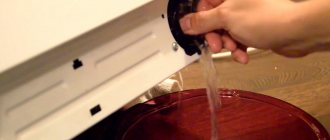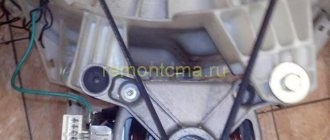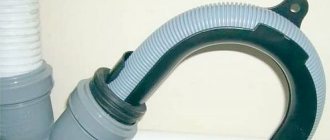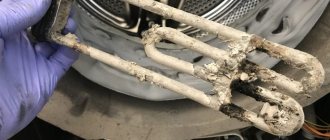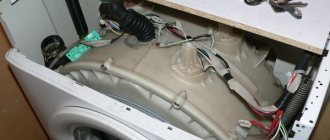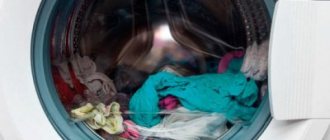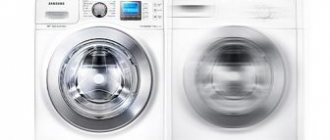The automatic washing machine is a brilliant invention of mankind. Most housewives simply cannot imagine their life without this wonderful assistant. This is not surprising. The washing machine not only washes the laundry on its own, it also rinses it, spins it, and some models even dry it. All this time the hostess can calmly go about her business.
However, sometimes the washing machine begins to tear clothes, causing troubles and losses to its users. For example, holes or tears suddenly appear on fresh, just washed laundry. But why does the washing machine tear clothes? There may be several reasons for this. Let's take a closer look at them.
Possible malfunctions of the washing machine
There are several reasons why a washing machine tears things. This may occur due to improper use of the device, accidental defects during assembly at the factory, or malfunction after several years of service. As a rule, the machine tears the laundry in the following cases:
- The wrong program has been selected or the spin speed has been set to high, causing damage to delicate items.
- Laundry detergents are incorrectly selected for a particular type of fabric.
- Loaded laundry contains zippers, hooks, buttons, bones and other sharp or metal objects that can damage items during washing.
- Foreign objects have gotten inside the washing machine drum.
- On the inner surface of the drum there may be defects such as chips, burrs, cracks, and sharp edges that are invisible to the naked eye.
- Damage to the loading hatch of a device with a vertical type of laundry loading. These could be springs, chips of plastic or iron, cracks, sharp edges on the doors.
- The drum of the washing machine is offset relative to its axis.
Possible problems should be considered in more detail to understand how to get rid of them.
Possible breakdowns
The following factors indicate that the equipment requires repair:
- Clothes get torn after washing.
- Pulls form on the fabric.
- The laundry is pulled into the gap between the hatch and the drum.
- Things get dirty.
- The device makes strange sounds during operation.
The breakdown must be repaired as quickly as possible so that neighboring components of the machine are not damaged.
Deformation of drum surfaces
Another reason for clothing damage can be damage inside the drum. They are a manufacturing defect or form after washing items with sharp decorative elements, heavy buckles and other hard objects that have fallen out of pockets.
Arm yourself with a flashlight and inspect the surface of the drum. Make sure nothing is sticking out of the multiple water fill holes. There should be no other holes in the drum.
You can also detect defects on the surface using nylon fabric. Put an old stocking on your hand and move it over the covering to find out where things get caught. The nylon will definitely get stuck on a sharp burr that you may not feel with your hand.
Minor damage can be repaired by sanding. Try this yourself with a sheet of fine sandpaper. If the deformation is significant, the tank will need to be replaced, since the drum cannot be purchased separately.
Expert opinion
I work in the household appliance repair industry. Extensive experience in restoring washing machines and dishwashers.
Ask a Question
If a defect is found in a new device, then you should not try to fix it yourself, because you have the right to demand a replacement of the product or compensation. To do this, you need to contact the store, write a statement and indicate the reason for returning the equipment.
Foreign objects
Craftsmen often encounter the problem of a metal bone from underwear getting stuck in the drum. Be sure to wash such items in a special mesh bag.
If foreign objects penetrate deep into the tank, they can cause great damage to the internal parts of the washer and cause losses to the user. The presence of foreign bodies in the mechanism reveals itself through such characteristic sounds during operation of the machine as ringing and grinding. You may hear an object hitting the SMA part.
After each wash, wiping the door and cuff, inspect the area for any foreign objects that may have fallen out of the pockets. Also, turn the drum a few times by hand to ensure that whatever remains after washing falls out.
Bearing wear
During long-term operation, the washing machine seal loses its tightness, which leads to water entering the bearing. Due to its gradual destruction from moisture, a gap is formed between the tank and the drum, into which clothes get chewed. The fabric tears as the drum rotates at high speed.
This happens due to the design features of horizontal loading equipment. The rotation and correct position of the drum is ensured by bearings. Worn parts don't do their job.
In addition, a damaged oil seal stains the laundry with dark grease. The bearing and seal are sold as a set and are replaced at the same time. To do this you need:
- remove the top cover of the washing machine;
- disconnect the counterweight;
- remove the back panel;
- disconnect the motor;
- remove shock absorbers;
- remove the façade with the seal;
- dismantle and disassemble the tank;
- remove the worn part;
- install a new bearing.
If you lack the appropriate skills, it is better to turn to a professional. If you do not replace this unit in time and continue to use the washing machine, the malfunction will become so serious that you will have to buy new equipment.
Do you wash your shoes in the machine?
Oh yes! No
Damage to the locking mechanism of vertical cabinets
The hatch of machines with vertical loading consists of two parts, they are fixed with a special mechanism. The body of this device is made of plastic. Therefore, closing the hatch too quickly is not recommended. This will lead to the plastic elements of the blocker splitting and the spring being exposed. The sharp edges of the chips will catch the fabric as the drum rotates.
The locking mechanism will have to be replaced. Until the problem is fixed, you should not use the washing machine, so as not to spoil things.
Following simple rules for operating a washing machine will help maintain the original appearance of your clothes and prevent them from tearing. Always empty your pockets and turn items inside out. Check the drum and cuff regularly; small objects may remain there. Do not overload the machine and select the correct wash cycle. If you cannot solve the problem yourself, contact the service center.
Wrong washing mode selected
Before using the washing machine, you should carefully study the instruction manual. It will be indicated there that for most types of fabrics there are special modes in which the laundry is washed efficiently and with the utmost care. Other programs may damage the item. Unfortunately, some housewives neglect this rule or believe that they understand better than the device manufacturer.
If the list of modes does not include a special program for a particular fabric, you should install the most gentle one, and also take into account the information on the clothing label. It provides useful information on how to properly wash an item so that it lasts for a long time.
Also, you should not abuse setting high speeds (more than 800) during spinning. The washing machine is likely to tear delicate fabrics during this procedure.
Sharp objects on clothing or inside the drum
Improper loading of clothes into the drum is another possible reason why the washing machine tears clothes.
According to the instruction manual, before loading items into the drum, you must remove all items from the pockets and also hide any metal or sharp parts. These can be zippers, buttons, dogs, rhinestones, etc. The easiest way to button and turn clothes inside out. If this is not possible, you should put it in a special laundry bag. It is mandatory to use this accessory to wash bras and items with solid decorations such as sequins, beads, beads, rhinestones, etc. When they come off the clothes, they can tear not only the item, but also damage the washing machine itself. There are often cases when a detached wire from a bra or a small self-tapping screw unnoticed in a pocket not only made many small holes in things, but also, once inside the device, pierced the tank, creating unnecessary complications and dooming the owner to expensive repairs.
To determine the presence of foreign objects, you should carefully examine the inside of the washing machine drum, and also inspect the areas in the immediate vicinity of the cuff, most carefully at the top of the loading hole. Also, when operating the washing machine, you may hear extraneous noises, such as knocks, ringing or grinding, which also indicate a problem.
To prevent the machine from tearing things, after each wash you need to remove the clothes and then turn the washing machine drum several times by hand. If there are any small items left inside, they will be detected. Sometimes they can get inside the cuff, so it needs to be folded back and carefully examined.
What to do if the machine tears your clothes
You yourself understand perfectly well that things can become unusable not because of breakdowns.
Therefore, I would like to save on repairs. In order not to call a specialist, we suggest that you figure out the problem yourself and fix it without outside help.
Small objects hit
When washing, sharp objects on clothes should be well hidden: clothes should be turned inside out or washed in special covers.
In addition, you need to shake out your clothes and check all pockets every time before washing. Any little thing - from a paper clip to a nail - can make a hole in a thing. What are the consequences if small objects leave the drum and travel into the tank? You will definitely have more worries - you will have to disassemble the case to remove the item.
If you are convinced that there is nothing unnecessary on your clothes or in their pockets, but history repeats itself every time, and you have already started darning holes, then the machine needs an inspection. A small bolt or other sharp and small object could be stuck in the cuff or drum, which tears the fabric. Inspect the entire drum, helping yourself with a flashlight. Walk through each fold of the seal and you will certainly find the source of the persistent holes.
Drum or hatch damaged
If everything is inspected, holes continue to appear, and you don’t know what to do - look for a defect! If you have a horizontal CM, first inspect the inside of the drum - there may be a burr or chip on it.
How to get rid of a hangnail? If the warranty card is still valid, do not waste time - exchange the car or return the money spent on it. It is not a fact that the manufacturers limited themselves to just one defect; another may emerge later.
And if the washer is not the first year, then try to clean out the defect by taking a sheet of fine sandpaper.
Do you have vertical SMA? If the door of such a machine is slammed too hard, the UBL breaks, which exposes the spring and chips the plastic. They also cling to underwear and tear it. In this case, repairs are needed: replacing the blocker. It is better not to use the equipment until the machine is repaired.
You can learn more about replacing the UBL in the article “How to replace a washing machine lock (UBL).”
Wrong mode selected
If you are used to washing all your clothes on the same cycle, then sooner or later you may encounter holes and tears. By setting delicate fabrics to Cotton 90 or even Synthetic 60, you are risking the integrity of the fabric.
Remember that intensive washing and spinning are not suitable for fabrics such as silk, wool and others.
Bearings are worn out
If the bearings fail, the drum shifts during washing - a large gap is formed, which the rubber seal can no longer cover. As a result, clothes fall into the resulting gap, and there they are mercilessly torn.
This is only relevant for machines with horizontal (regular) loading.
In short, the bearing replacement process looks like this:
- All panels are removed (top, rear, front).
- Parts are disconnected (counterweights, electric motor, pump, shock absorbers).
- The tank is dismantled and disassembled.
- Bearings are removed and new ones are installed.
You will find detailed instructions with photos and videos in the article “How to replace bearings in a washing machine.”
We advise you to take on the task only if you are confident in your abilities. If your washing machine model has a glued tank, you will have to saw it and glue it back together. Are you ready for such difficulties?
If yes, then proceed carefully, film the disassembly process on video (to put everything back together) and feel free to change the bearings.
After repair, your washing machine will no longer tear clothes if you follow the operating instructions.
Defects in the drum or loading hatch
If a new washing machine tears things, this may indicate a manufacturing defect.
To detect it, it is necessary, armed with a flashlight, to carefully examine the drum from the inside. There should be no holes on its inner surface, except for the technological holes for filling water, provided by the manufacturer and having a diameter of 3-4 mm.
If a visual inspection does not reveal any damage, you should take old women's tights or stockings, put them on your hand and carefully examine every centimeter of the inner surface of the drum, running your hand along it. If a metal burr or chip is really present, it will definitely reveal itself during such a check.
If a defect is found in a new washing machine, it is recommended to contact the store and write an application for an exchange of goods or a refund. If the device is old, you can solve the problem on your own by cleaning the problem area with fine sandpaper. Work very carefully, otherwise you may cause further damage to the surface of the drum. You should definitely think about the cause of the defect, because this may indicate a complex breakdown. In addition to a malfunction, such defects can be caused by a metal object, such as a nut, bolt or nail, getting inside the washing machine drum. At high spin speeds, they are quite capable of leaving a scratch.
On top-loading washing machines, you need to carefully examine the door. On its inside there is a device responsible for blocking the hatch of the washing machine. If you close the lid abruptly, it may crack, with sharp parts or a spring sticking out. When washing, they will tear things, so the device needs to be repaired urgently.
What to do if the machine tears your clothes
You yourself understand perfectly well that things can become unusable not because of breakdowns. Therefore, I would like to save on repairs.
In order not to call a specialist, we suggest that you figure out the problem yourself and fix it without outside help.
Small objects hit
When washing, sharp objects on clothes should be well hidden: clothes should be turned inside out or washed in special covers.
In addition, you need to shake out your clothes and check all pockets every time before washing. Any little thing - from a paper clip to a nail - can make a hole in a thing. What are the consequences if small objects leave the drum and travel into the tank? You will definitely have more worries - you will have to disassemble the case to remove the item.
If you are convinced that there is nothing unnecessary on your clothes or in their pockets, but history repeats itself every time, and you have already started darning holes, then the machine needs an inspection. A small bolt or other sharp and small object could be stuck in the cuff or drum, which tears the fabric. Inspect the entire drum, helping yourself with a flashlight. Walk through each fold of the seal and you will certainly find the source of the persistent holes.
Drum or hatch damaged
If everything is inspected, holes continue to appear, and you don’t know what to do - look for a defect! If you have a horizontal CM, first inspect the inside of the drum - there may be a burr or chip on it.
How to get rid of a hangnail? If the warranty card is still valid, do not waste time - exchange the car or return the money spent on it. It is not a fact that the manufacturers limited themselves to just one defect; another may emerge later.
And if the washer is not the first year, then try to clean out the defect by taking a sheet of fine sandpaper.
Do you have vertical SMA? If the door of such a machine is slammed too hard, the UBL breaks, which exposes the spring and chips the plastic. They also cling to underwear and tear it. In this case, repairs are needed: replacing the blocker. It is better not to use the equipment until the machine is repaired.
You can learn more about replacing the UBL in the article “How to replace a washing machine lock (UBL).”
Wrong mode selected
If you are used to washing all your clothes on the same cycle, then sooner or later you may encounter holes and tears. By setting delicate fabrics to Cotton 90 or even Synthetic 60, you are risking the integrity of the fabric.
Remember that intensive washing and spinning are not suitable for fabrics such as silk, wool and others.
Bearings are worn out
If the bearings fail, the drum shifts during washing - a large gap is formed, which the rubber seal can no longer cover. As a result, clothes fall into the resulting gap, and there they are mercilessly torn.
This is only relevant for machines with horizontal (regular) loading.
In short, the bearing replacement process looks like this:
- All panels are removed (top, rear, front).
- Parts are disconnected (counterweights, electric motor, pump, shock absorbers).
- The tank is dismantled and disassembled.
- Bearings are removed and new ones are installed.
You will find detailed instructions with photos and videos in the article “How to replace bearings in a washing machine.”
Washing machine drum offset
Situations very often occur when an item becomes caught between the edge of the tub and the drum of the washing machine during washing. And at a high speed of rotation of the drum, the device tears the thing. As a result, the owner, instead of his favorite thing, will receive a torn rag that can only be thrown away. To understand why a machine tears things, you need to know the design of a front-loading washing machine.
In this case, the washing machine tears the clothes due to a faulty bearing. These items rotate the drum and keep it in the correct horizontal position, and also prevent it from moving to the side while working under the weight of heavy wet things. After a breakdown, they cease to perform their functions, as a result the drum moves, and a gap appears between it and the edges of the tank. The machine will pinch and tear the item if it gets into the gap during washing or spinning.
It is very difficult to repair such a breakdown on your own. You must contact the service center and call a qualified specialist.
If the owner decides to fix the problem on his own, he will need to perform the following sequence of actions:
- Remove the cover and back wall of the washing machine,
- Disconnect the counterweight, pump, motor and shock absorbers,
- Remove the front wall together with the attached cuff of the loading hatch,
- Disconnect and disassemble the tank,
- Replace the damaged bearing with a new one,
- Assemble the washing machine.
The process is very complex, therefore, if you are not sure that the repair on your own will be completed successfully, it is still better to entrust it to professionals.
In addition to the reasons described above, it should be mentioned that the washing machine should not be overloaded. Firstly, this negatively affects its operation; in this case, the bearings wear out faster. Secondly, if there are a lot of things, the water will not dissolve all the powder, which means that the laundry sprinkled with powder will rub much more strongly. As a result, the washing machine will soon tear the item.
Permissible independent actions
Without theoretical knowledge about the design of SMAs and basic skills in working with household appliances, you should not fix complex defects with your own hands. You can try to deal with minor flaws that do not require disassembling the machine.
- Change the washing mode.
- Distribute the load correctly (avoid overload).
- Remove foreign object. This can be done if the part has not yet sunk deep.
- Sand the surface of the drum if there are small chips or burrs.
- Replace bearings. The process consists of four stages: remove all panels of the device (to do this, unscrew the mounting screws);
- disconnect elements (counterweights, shock absorbers, etc.);
- remove the tank and disassemble it;
- replace faulty bearings with new ones, and then reassemble the device to its original state.
However, many experts do not recommend performing the procedure yourself if you have not previously had experience in similar work: if disassembled incorrectly, serviceable modules can be damaged.
In all other cases, it is advisable to contact the service for qualified repairs.
How to protect clothes from damage when washing
So, it is not uncommon for washing equipment to tear things due to improper actions of the owner. To prevent the machine from tearing things, you should follow these simple steps:
- Before washing, inspect pockets and empty their contents.
- Fasten zippers, buttons, rivets, turn things inside out,
- To prevent the washing machine from tearing things, delicate items and items with hard decorations should be washed in a special bag,
- If there are doubts about the quality and strength of an item, it is necessary to choose the most gentle program and set the lowest number of revolutions during spinning,
- Choose a laundry detergent that is safe for fabrics,
- Do not overload the washing machine,
- After completion of work, you should inspect the drum and cuff of the washing machine for the presence of small objects.
If these rules are followed, the safety and integrity of your favorite things is practically guaranteed.
Why do things tear?
It is rarely possible to immediately find the cause of trouble. If you remove damaged items from the machine, you need to make sure that they did not end up in the drum already damaged. When you are sure that the laundry was intact, you need to inspect the machine. The fabric in it may tear during washing due to:
- The presence of pointed edges;
- Foreign objects that have fallen out of clothing or otherwise entered the drum;
- Bearing failures;
- Inappropriate mode.


